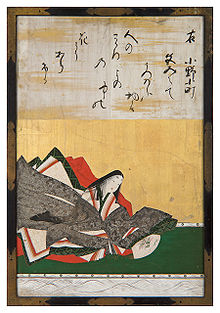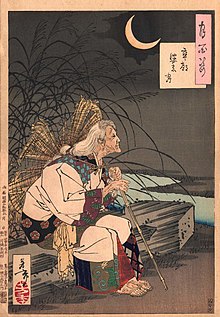Ono no Komachi: Difference between revisions
Magioladitis (talk | contribs) m clean up using AWB (10244) |
No edit summary |
||
| Line 86: | Line 86: | ||
[[Category:900 deaths]] |
[[Category:900 deaths]] |
||
[[Category:Japanese poets]] |
[[Category:Japanese poets]] |
||
[[Category:9th-century women writers]] |
|||
[[Category:Place of birth unknown]] |
[[Category:Place of birth unknown]] |
||
[[Category:Ono (Japanese clan)]] |
[[Category:Ono (Japanese clan)]] |
||
Revision as of 00:12, 2 February 2015



Ono no Komachi (小野 小町, c. 825 – c. 900) was a Japanese waka poet, one of the Rokkasen—the Six best Waka poets of the early Heian period. She was renowned for her unusual beauty, and Komachi is today a synonym for feminine beauty in Japan. She also counts among the Thirty-six Poetry Immortals.
Life and legends
The place of Komachi's birth and death is uncertain, but it is known that she was born in 825 AD and died in 900 AD. According to one tradition, she was born in what is now Akita Prefecture, daughter of Yoshisada, Lord of Dewa.[1] Her social status is also uncertain. She may have been a low-ranking consort or a lady-in-waiting of an emperor, possibly Emperor Ninmyō (r. 833-850).
As a poet, Komachi specialized in erotic love themes, expressed in complex poems.[2] Most of her waka are about anxiety, solitude or passionate love. She is the only female poet referred to in the preface of the Kokin Wakashū, which describes her style as "containing naivety in old style but also delicacy".
Legends abound of Komachi in love. The most well known is a story about her relationship with Fukakusa no Shosho, a high-ranking courtier. Komachi promised that if he visited her continuously for a hundred nights, then she would become his lover. Fukakusa no Shosho visited her every night, but failed once towards the end. Despairing, he fell ill and subsequently died. When Komachi learned of his death she was overcome with grief.
Legacy
Komachi sometimes features in later-period literature, including five[3] Noh plays: Sotoba Komachi, Sekidera Komachi, Ōmu Komachi, Sōshi Arai Komachi and Kayoi Komachi. These works tend to focus on her talent for waka and her love affairs and the vanity of a life spent indulging in romantic liaisons. Komachi's old age is also frequently portrayed: when she has lost her beauty, has been abandoned by her former lovers, and now regrets her life, wandering around as a lonely beggar woman — albeit still appreciated by young admirers of her poetry.[1] This fictional description is influenced by Buddhist thought and there may be no factual resemblance between it and the historical reality.
In her honor, the Akita Shinkansen is nicknamed Komachi. A variety of rice, Akita Komachi, also bears her name. One of her 31-syllable poems was chosen by Fujiwara no Teika to be an entry in the Hyakunin Isshu anthology.
Sotoba Komachi ("Komachi on the stupa") is a Noh play reworked from the ancient original by Mishima Yukio for the modern theater. The basic plot (the age-worn former beauty encounters a young poet and relates some of her life's story, which causes him to fall in love with her, with fatal results) is retained, but the action takes place in a public park, with flashbacks to the salons and ballrooms of Meiji-era Japan. An English translation by Donald Keene was published in 1967.
The play Three Poets by playwright Romulus Linney includes a one act story about Komachi the poet.[4]
Example of her work
| Original Japanese Text | Roman characters | Approximate meaning |
|---|---|---|
| 花の色は 移りにけりな いたずらに 我が身世にふる ながめせしまに |
Hana no iro wa Utsurinikeri na Itazura ni Wa ga mi yo ni furu Nagame seshi ma ni |
The flower colors wilted and faded away while I meaninglessly existed in this world as the long lasting rain continued |
Notes
- ^ a b Rexroth (1977:141)
- ^ "Her beauty may be legendary but her rank as one of the greatest erotic poets in any language is not. Her poems begin the extreme verbal complexity which distinguishes the poetry of the Kokinshū Anthology from the presentational immediacy of the Man'yōshū." Rexroth (1977:141)
- ^ Keene (1970:67)
- ^ Gussow, Mel (23 November 1989). "Review/Theater; Women Who Wrote Verse and Suffered". New York Times. Retrieved 27 November 2011.
References
- Hirshfield, Jane; Aratani, Mariko (1990). The Ink Dark Moon: Love Poems by Ono no Komachi and Izumi Shikibu, Women of the Ancient Court of Japan. New York: Vintage Books. ISBN 0-679-72958-5.
- Keene, Donald (1970). Twenty Plays of the Nō Theater. New York: Columbia University Press. ISBN 0-231-03454-7.
- Rexroth, Kenneth; Atsumi, Ikuko (1977). Woman poets of Japan. New York: New Directions Pub. Corp. ISBN 0-8112-0820-6.
